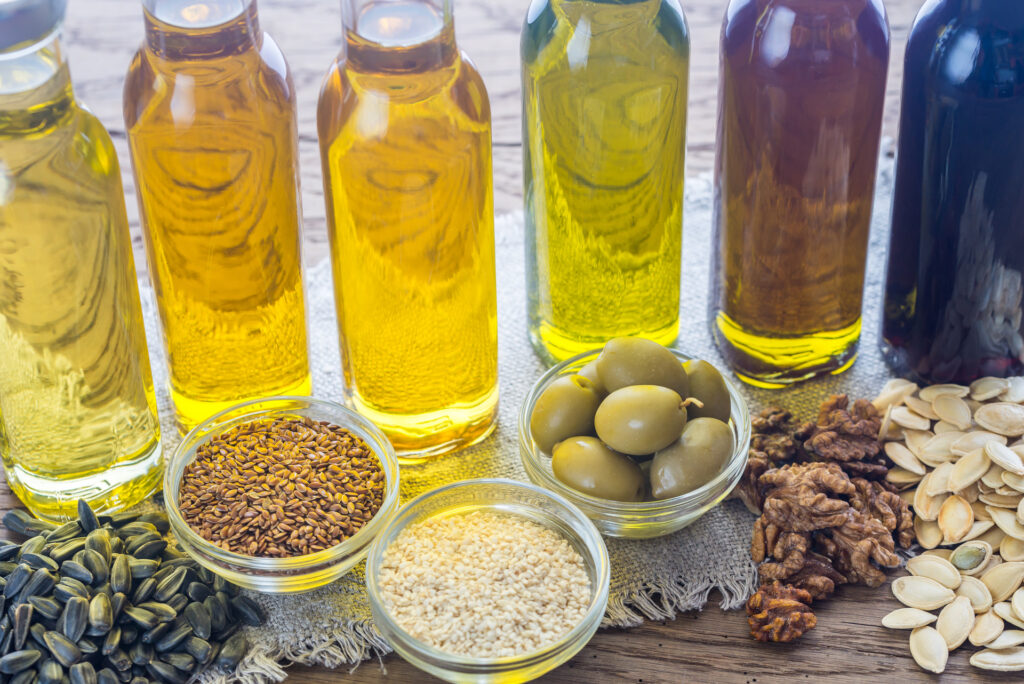
Cooking oils are essential in the kitchen for their functional role in frying and sautéing and the unique flavours and health benefits they bring to dishes. Knowing which oil to choose for specific cooking methods can be challenging, with many options. Chef Abdul breaks down the best oils for various purposes, helping you make informed and flavourful choices.
Best For
Olive oil is a cornerstone of Mediterranean cuisine, celebrated for its fruity flavour and health benefits. Extra virgin olive oil (EVOO) is cold-pressed and unrefined, making it ideal for dressings and drizzling, while regular olive oil is better suited for cooking due to its higher smoke point.
Chef Abdul’s Tip:
Use EVOO for fresh salads, roasted vegetables, and bread dipping. Opt for lighter olive oil for frying or baking to prevent overpowering flavours.
Best For
With a high smoke point of around 520°F (271°C), avocado oil is perfect for high-temperature cooking. It’s mild and buttery, making it a versatile choice for savoury and sweet dishes.
Chef Abdul’s Favourite Use:
Grill vegetables or make homemade mayonnaise with avocado oil for a creamy, neutral flavour.
Best For
Coconut oil adds a subtle sweetness and richness to dishes. It’s solid at room temperature and ideal for recipes with a hint of tropical flavour. Virgin coconut oil retains its coconut aroma, while refined coconut oil is neutral.
Chef Abdul’s Tip:
For an exotic twist, bake cookies, fry pancakes, or sauté vegetables with a pinch of curry powder in coconut oil.
Best For
Sunflower oil has a neutral flavour and a high smoke point, making it a favourite for frying and roasting. It’s light, versatile, and widely used in everyday cooking.
Chef Abdul’s Tip:
For a healthier option, look for high-oleic sunflower oil containing more heart-healthy fats.
Best For
Sesame oil comes in two varieties: light and toasted. Light sesame oil has a high smoke point, making it suitable for frying, while toasted sesame oil is intensely flavourful and best used as a finishing oil.
Chef Abdul’s Favourite Use:
Drizzle toasted sesame oil over stir-fried noodles or use it in a soy-based dipping sauce for dumplings.
Best For
Grapeseed oil is light, neutral, and has a moderately high smoke point, making it a versatile choice for cooking and baking. It’s also excellent for creating creamy vinaigrettes and sauces.
Chef Abdul’s Tip:
Blend grapeseed oil with herbs and garlic to create a versatile marinade for vegetables or fish.
Best For
Peanut oil’s high smoke point and nutty flavour make it ideal for frying, particularly in Asian-inspired dishes. It’s a popular choice for deep-fried snacks like samosas or tempura.
Chef Abdul’s Favourite Use:
Frying spring rolls or creating a peanut dressing for noodle salads.
Best For
Flaxseed oil is rich in omega-3 fatty acids but has a low smoke point, so it’s unsuitable for cooking. Instead, it can be used as a finishing oil to enhance the nutritional profile of dishes.
Chef Abdul’s Tip:
Add a drizzle of flaxseed oil to yoghurt bowls or use it as a base for citrus vinaigrettes.
Best For
Canola oil is mild, affordable, and versatile, making it a go-to choice for everyday cooking. Its high smoke point and neutral flavour allow it to blend seamlessly into any dish.
Chef Abdul’s Favourite Use:
Using canola oil for crispy pakoras or moist cakes without adding unwanted flavours.
Best For
Mustard oil is pungent and flavourful, adding a distinct spiciness to dishes. Traditionally used in Indian and Bengali cuisines, it’s great for tempering spices and adding depth to curries.
Chef Abdul’s Tip:
Use mustard oil to make masala-infused vegetables, or drizzle it over lentil soups for a smoky finish.
Choosing the Right Oil for the Job
Here’s a quick guide to matching oils with your cooking methods:
The right cooking oil can transform a dish, enhancing its flavour and texture. Chef Abdul encourages experimenting with different oils to discover their unique properties and flavours. As he says, “Cooking with oils is like painting with colours—each one adds its character to the masterpiece on your plate.”
Incorporate these oils into your kitchen repertoire and elevate your everyday cooking to a flavourful art form!
Chef Abdul © Copyright 2024. All rights reserved.